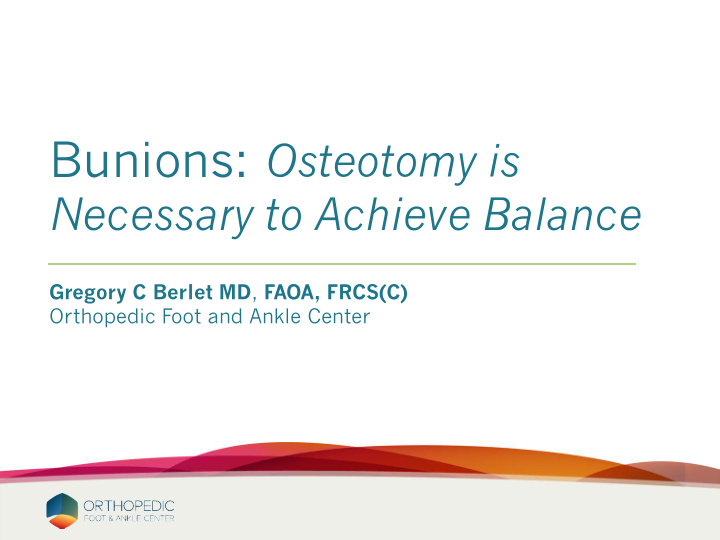



Bunions: Osteotomy is Necessary to Achieve Balance Gregory C Berlet MD , FAOA, FRCS(C) Orthopedic Foot and Ankle Center
Key Elements: Bunion Correction Pati tient t Goals: • That it was worth the cost and time – Perception of improvement – Appealing cosmetic appearance • Functional motion • All in a time frame that does not sig compromise work / family responsibilities
Key Elements: Bunion Correction Surge geon Considerations: 1. IM angle correction 2. Sesamoid reduction 3. Articular congruity 4. Rotation 5. Functional motion 6. Medial column stability
Medial Column Instability Controversy: Is a Bunion a ……. Fundamental Biomechanical Flaw of the Foot or Isolated Deformity Requiring Re-Balancing
1 st TMT Instability • Hansen commenting on Bunions: – Bunion is a symptom of a greater and more complex dysfunction of the extremity – Bunion is one of the most common manifestations of gastroc contracture and mobile 1 st ray – Management by means of dozens of techniques in literature is simplistic Hansen: Functional Reconstruction of the Foot and Ankle 2000
Fundamental Flaw: One Operation for Bunions LAPIDUS FUSION
Bunion as an Isolated Condition Coughlin and Jones (2007): • Hallux Valgus and First Ray Mobility • Proximal osteotomy for bunion outcomes: • 90 – 95% good to excellent • Systematically evaluated the atavistic traits • How common ? • Influence on outcome of bunion surgery? Coughlin MJ, Jones CP: JBJS 89(9) , 2007
HV and 1 st Ray Mobility • 103 patients, min 2 year follow up • Proximal crescentic osteotomy + DSTP • Outcome parameters: – AOFAS – Ankle range of motion – Harris mat prints – 1 st TMT motion – Klaue device – Radiographs Coughlin MJ, Jones CP: JBJS 89(9) , 2007
Hypermobility ∞ Alignment Increased preoperative mobility of the first ray: • Regularly and consistently reduced to a NORMAL range without fusion • Stability of the first ray is a function of the ALIGNMENT of the first ray and is not an intrinsic characteristic of the first metatarsocuneiform joint. Coughlin MJ, Jones CP: JBJS 89(9) , 2007
Coughlinites: Save the Joint Before After Proximal Metatarsal Osteotomy
State of Practice: 2006 Hypothetical Case: Severe Bunion Deformity 50 year old female IM 20 0 ; HVA 42 0 • 105 orthopedic academic foot and ankle – 52% metatarsal osteotomy * * – 26% 1 st MTP arthrodesis – 24% 1 st TMT arthrodesis ( lapidus ) – Secondary procedures: Akin 30% Pinney, Song, Chou: FAI 27(12); 2006
My Approach : 2017 Metatarsal Osteotomies: • Scarf almost exclusively – Short arm when I used to use chevron – Long arm for greater IM angle correction • Proximal wedge removed to allow for angular correction at the DMAA ( preserve congruity)
Sesamoid Reduction is the KEY
Sesamoids Not all the Same 26% of specimens with HV there was abnormal metatarsal pronation with absence of sesamoid deviation from articular facet Kim et al, FAI 36(8), 2015
My Approach: 2017 Pre Operative Planning Sesamoid View: Reduced Sesamoids ( pronation deformity of the metatarsal) = Derotational Lapidus with no DSTP Malreduced Sesamoids • Mild deformity = short arm Scarf • Significant deformity = regular Scarf • In combination with a DSTP
My Approach : 2017 Peri articular Osteotomies: • Akin 50% of the time – Driven by hallux valgus interphalangeus – Position of toe relative to 2 nd – Occasionally by rotation of hallux • Oblique osteotomy secured by headless compression screw
My Approach : 2017 Motion and Physical Therapy: • Early joint mobilization is key • No strapping, believe in your correction • PT at 2 weeks to teach passive and active assisted joint mobilization • Intrinsic and extrinsic strengthening at 6 weeks
Osteotomies Most of The Time • Get obsessed with sesamoid position – Soft tissue balancing ( DSTP / capsule ) – Metatarsal angular correction including rotation • Osteotomy is the answer in at least 75% of my bunion cases
THANK YOU
Recommend
More recommend